CscGAN: Conditional Scale-Consistent Generation Network for Multi-Level Remote Sensing Image to Map Translation
Abstract
1. Introduction
- One-to-one mapping-based methods usually use two ways to implement map generation with multiple levels, that is, separated training at each level and uniform training with multiple levels. For the former way, tile maps at each level are trained separately, which makes the time and space complexity of the model very high. Meanwhile, due to the low utilization of the training set during the separated training, a larger amount of training samples are needed. For the latter way, the unified training of RS images with different levels can easily cause multi-level information confusion and detailed information loss at a finer level. As shown in Figure 1, the uniformly trained pix2pix did not discriminate RS images from which levels, resulting in generating the confusing contents at the 17th level (maybe from the 18th level), meanwhile, the loss of important contents such as the green land at the finer level (see the red rectangles in Figure 1).
- Many-to-many mapping-based methods usually use one generator and auxiliary information to complete multi-level map generation, leading to the errors of detailed content generated at higher levels. For example, as shown in Figure 1, although the StarGAN generated the green land at the 18th level map, the generated land contained a lot of false information and also lost a lot of details (see the red rectangle in the Figure 1b).
- A single and unified multi-level map generation model, called CscGAN, is proposed to learn the mappings among multiple levels, training effectively and efficiently from multi-scale RS images and annotation images with different levels and resolutions. As far as we know, this is the first model to simultaneously generate different tile maps in multiple levels.
- Two multi-scale discriminators and a multi-scale generator are designed for jointly learning both high-resolution and low-resolution representations, aiming to produce high-quality tile maps with rich details at different levels.
- A map-level classifier is introduced to guide the network for discriminating the learned representations from which level, improving the stability and efficiency of adversarial training in multi-level map generation.
- We construct and label a new RS-image-to-map dataset for multi-level map generation and analysis referred to as the “self-annotated RS-image-to-map dataset”. Extensive experiments on two datasets and cross study areas show that the CscGAN outperforms the state-of-the-art methods for the quality of different levels of map translation.
2. Related Work
2.1. Image-to-Image Translation
2.2. Automatic Map Translation from RS Images
3. Materials
3.1. Maps Dataset
3.2. Self-Annotated RS-Image-to-Map Dataset and Study Areas
4. Methods
4.1. The Overview of the Method
4.2. Multi-Scale Generator
4.3. Multi-Scale Discriminator
4.4. Map-Level Classifier
5. Experiments and Analysis
5.1. Evaluation Metrics
5.1.1. Peak Signal to Noise Ratio (PSNR)
5.1.2. Structural Similarity (SSIM)
5.1.3. Pixel Accuracy
5.1.4. Accuracy, Precision, Recall, F1 Score, ROC Curves
5.2. Implementation Details
5.2.1. Training Details
5.2.2. Experimental Machine Configuration
5.3. Evaluation of Maps Dataset
5.4. Evaluation of the Self-Annotated RS-Image-to-Map Dataset
5.5. Ablation Experiment and Study
5.6. Generalization Analysis of Cross Study Areas
5.7. Result Analysis and Discussion of Study Areas with Different Levels
6. Conclusions
Author Contributions
Funding
Institutional Review Board Statement
Informed Consent Statement
Data Availability Statement
Acknowledgments
Conflicts of Interest
Appendix A

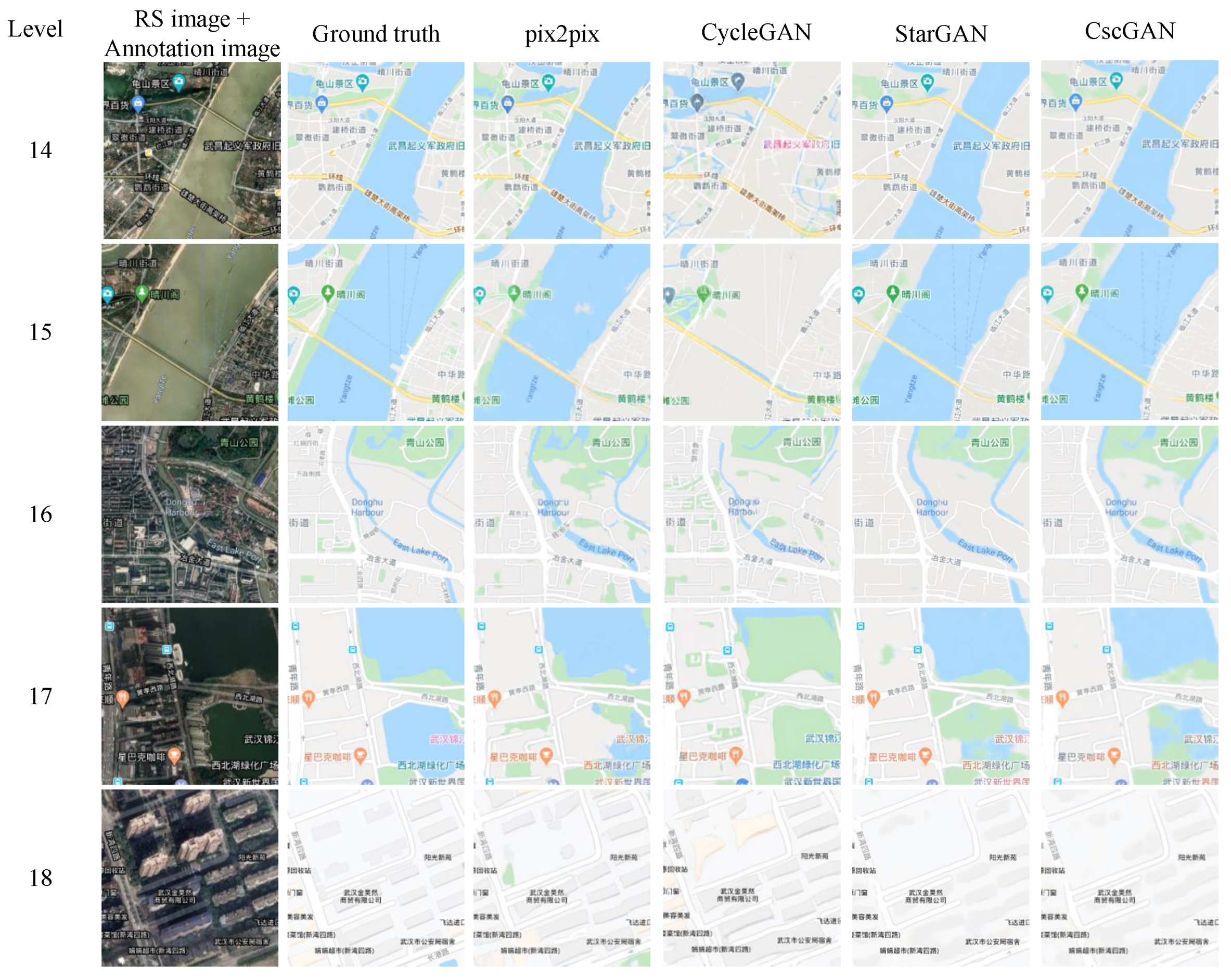
References
- Jing, Y. Research on Large Scale Vector Electronic Map Data Production Based on ArcGIS. Geomat. Spat. Inf. Technol. 2015, 38, 135–136. [Google Scholar]
- Isola, P.; Zhu, J.Y.; Zhou, T.; Efros, A.A. Image-to-Image Translation with Conditional Adversarial Networks. In Proceedings of the IEEE Conference on Computer Vision and Pattern Recognition, Honolulu, HI, USA, 21–26 July 2017; pp. 1125–1134. [Google Scholar]
- Zhu, J.Y.; Park, T.; Isola, P.; Efros, A.A. Unpaired Image-to-Image Translation Using Cycle-Consistent Adversarial Networks. In Proceedings of the IEEE International Conference on Computer Vision, Venice, Italy, 22–29 October 2017; pp. 2223–2232. [Google Scholar]
- Fu, H.; Gong, M.; Wang, C.; Batmanghelich, K.; Zhang, K.; Tao, D. Geometry-Consistent Generative Adversarial Networks for One-Sided Unsupervised Domain Mapping. In Proceedings of the IEEE Conference on Computer Vision and Pattern Recognition, Long Beach, CA, USA, 16–20 June 2019; pp. 2427–2436. [Google Scholar]
- Choi, Y.; Choi, M.; Kim, M.; Ha, J.W.; Kim, S.; Choo, J. StarGAN: Unified Generative Adversarial Networks for Multi-Domain Image-to-Image Translation. In Proceedings of the 2018 IEEE/CVF Conference on Computer Vision and Pattern Recognition, Salt Lake City, UT, USA, 18–23 June 2018; pp. 8789–8797. [Google Scholar] [CrossRef]
- Choi, Y.; Uh, Y.; Yoo, J.; Ha, J.W. Stargan v2: Diverse Image Synthesis for Multiple Domains. In Proceedings of the IEEE/CVF Conference on Computer Vision and Pattern Recognition, Seattle, WA, USA, 13–19 June 2020; pp. 8188–8197. [Google Scholar]
- Marmanis, D.; Wegner, J.D.; Galliani, S.; Schindler, K.; Datcu, M.; Stilla, U. Semantic segmentation of aerial images with an ensemble of CNSS. ISPRS Ann. Photogramm. Remote Sens. Spat. Inf. Sci. 2016 2016, 3, 473–480. [Google Scholar] [CrossRef]
- Wu, H.; Zhang, H.; Zhang, X.; Sun, W.; Zheng, B.; Jiang, Y. DeepDualMapper: A gated fusion network for automatic map extraction using aerial images and trajectories. Proc. AAAI Conf. Artif. Intell. 2020, 34, 1037–1045. [Google Scholar] [CrossRef]
- Kaiser, P.; Wegner, J.D.; Lucchi, A.; Jaggi, M.; Hofmann, T.; Schindler, K. Learning aerial image segmentation from online maps. IEEE Trans. Geosci. Remote Sens. 2017, 55, 6054–6068. [Google Scholar] [CrossRef]
- Hinz, S.; Baumgartner, A. Automatic extraction of urban road networks from multi-view aerial imagery. ISPRS J. Photogramm. Remote Sens. 2003, 58, 83–98. [Google Scholar] [CrossRef]
- Hu, J.; Razdan, A.; Femiani, J.C.; Cui, M.; Wonka, P. Road Network Extraction and Intersection Detection From Aerial Images by Tracking Road Footprints. IEEE Trans. Geosci. Remote Sens. 2007, 45, 4144–4157. [Google Scholar] [CrossRef]
- Goodfellow, I.; Pouget-Abadie, J.; Mirza, M.; Xu, B.; Warde-Farley, D.; Ozair, S.; Courville, A.; Bengio, Y. Generative Adversarial Nets. In Advances in Neural Information Processing Systems; MIT Press: Cambridge, MA, USA, 2014; pp. 2672–2680. [Google Scholar]
- Wang, T.C.; Liu, M.Y.; Zhu, J.Y.; Tao, A.; Kautz, J.; Catanzaro, B. High-Resolution Image Synthesis and Semantic Manipulation with Conditional Gans. In Proceedings of the IEEE Conference on Computer Vision and Pattern Recognition, Salt Lake City, UT, USA, 18–22 June 2018; pp. 8798–8807. [Google Scholar]
- Yi, Z.; Zhang, H.; Tan, P.; Gong, M. Dualgan: Unsupervised Dual Learning for Image-to-Image Translation. In Proceedings of the IEEE International Conference on Computer Vision, Venice, Italy, 22–29 October 2017; pp. 2849–2857. [Google Scholar]
- Lin, Y.J.; Wu, P.W.; Chang, C.H.; Chang, E.; Liao, S.W. RelGAN: Multi-Domain Image-to-Image Translation via Relative Attributes. In Proceedings of the 2019 IEEE/CVF International Conference on Computer Vision (ICCV), Seoul, Korea, 27 October–2 November 2019; pp. 5913–5921. [Google Scholar] [CrossRef]
- Arjovsky, M.; Chintala, S.; Bottou, L. Wasserstein gan. arXiv 2017, arXiv:1701.07875. [Google Scholar]
- Arjovsky, M.; Bottou, L. Towards Principled Methods for Training Generative Adversarial Networks. Stat 2017, 1050, 17. [Google Scholar]
- Salimans, T.; Goodfellow, I.J.; Zaremba, W.; Cheung, V.; Radford, A.; Chen, X. Improved Techniques for Training GANs. arXiv 2016, arXiv:1606.03498. [Google Scholar]
- Radford, A.; Metz, L.; Chintala, S. Unsupervised Representation Learning with Deep Convolutional Generative Adversarial Networks. arXiv 2016, arXiv:1511.06434. [Google Scholar]
- Gulrajani, I.; Ahmed, F.; Arjovsky, M.; Dumoulin, V.; Courville, A.C. Improved Training of Wasserstein Gans. arXiv 2017, arXiv:1704.00028. [Google Scholar]
- Mao, X.; Li, Q.; Xie, H.; Lau, R.Y.; Wang, Z.; Paul Smolley, S. Least Squares Generative Adversarial Networks. In Proceedings of the IEEE International Conference on Computer Vision, Venice, Italy, 22–29 October 2017; pp. 2794–2802. [Google Scholar]
- Zhang, H.; Xu, T.; Li, H.; Zhang, S.; Wang, X.; Huang, X.; Metaxas, D.N. StackGAN: Text to Photo-Realistic Image Synthesis with Stacked Generative Adversarial Networks. In Proceedings of the IEEE International Conference on Computer Vision (ICCV), Venice, Italy, 22–29 October 2017. [Google Scholar]
- Zhang, H.; Xu, T.; Li, H.; Zhang, S.; Wang, X.; Huang, X.; Metaxas, D.N. Stackgan++: Realistic Image Synthesis with Stacked Generative Adversarial Networks. IEEE Trans. Pattern Anal. Mach. Intell. 2018, 41, 1947–1962. [Google Scholar] [CrossRef] [PubMed]
- Karras, T.; Aila, T.; Laine, S.; Lehtinen, J. Progressive Growing of GANs for Improved Quality, Stability, and Variation. arXiv 2017, arXiv:1710.10196. [Google Scholar]
- Karnewar, A.; Wang, O. Msg-Gan: Multi-Scale Gradients for Generative Adversarial Networks. In Proceedings of the IEEE/CVF Conference on Computer Vision and Pattern Recognition, Seattle, WA, USA, 13–19 June 2020; pp. 7799–7808. [Google Scholar]
- Li, J.; Chen, Z.; Zhao, X.; Shao, L. MapGAN: An Intelligent Generation Model for Network Tile Maps. Sensors 2020, 20, 3119. [Google Scholar] [CrossRef] [PubMed]
- Xu, C.; Zhao, B. Satellite Image Spoofing: Creating Remote Sensing Dataset with Generative Adversarial Networks (Short Paper). In Proceedings of the 10th International Conference on Geographic Information Science (GIScience 2018), Melbourne, Australia, 28–31 August 2018. [Google Scholar]
- Deng, X.; Zhu, Y.; Newsam, S. What is it like down there? Generating dense ground-level views and image features from overhead imagery using conditional generative adversarial networks. In Proceedings of the 26th ACM SIGSPATIAL International Conference on Advances in Geographic Information Systems, Seattle, WA, USA, 6–9 November 2018; pp. 43–52. [Google Scholar]
- Mao, Q.; Lee, H.Y.; Tseng, H.Y.; Ma, S.; Yang, M.H. Mode Seeking Generative Adversarial Networks for Diverse Image Synthesis. In Proceedings of the 2019 IEEE/CVF Conference on Computer Vision and Pattern Recognition (CVPR), Long Beach, CA, USA, 15–21 June 2019; pp. 1429–1437. [Google Scholar] [CrossRef]
- Chu, C.; Zhmoginov, A.; Sandler, M. CycleGAN, a Master of Steganography. arXiv 2017, arXiv:1712.02950. [Google Scholar]
- Hore, A.; Ziou, D. Image Quality Metrics: PSNR vs. SSIM. In Proceedings of the 2010 20th International Conference on Pattern Recognition, Istanbul, Turkey, 23–26 August 2010; pp. 2366–2369. [Google Scholar] [CrossRef]
- Wang, Z.; Bovik, A.C.; Sheikh, H.R.; Simoncelli, E.P. Image Quality Assessment: From Error Visibility to Structural Similarity. IEEE Trans. Image Process. 2004, 13, 600–612. [Google Scholar] [CrossRef] [PubMed]
- Paszke, A.; Gross, S.; Massa, F.; Lerer, A.; Bradbury, J.; Chanan, G.; Killeen, T.; Lin, Z.; Gimelshein, N.; Antiga, L.; et al. PyTorch: An Imperative Style, High-Performance Deep Learning Library. arXiv 2019, arXiv:1912.01703. [Google Scholar]
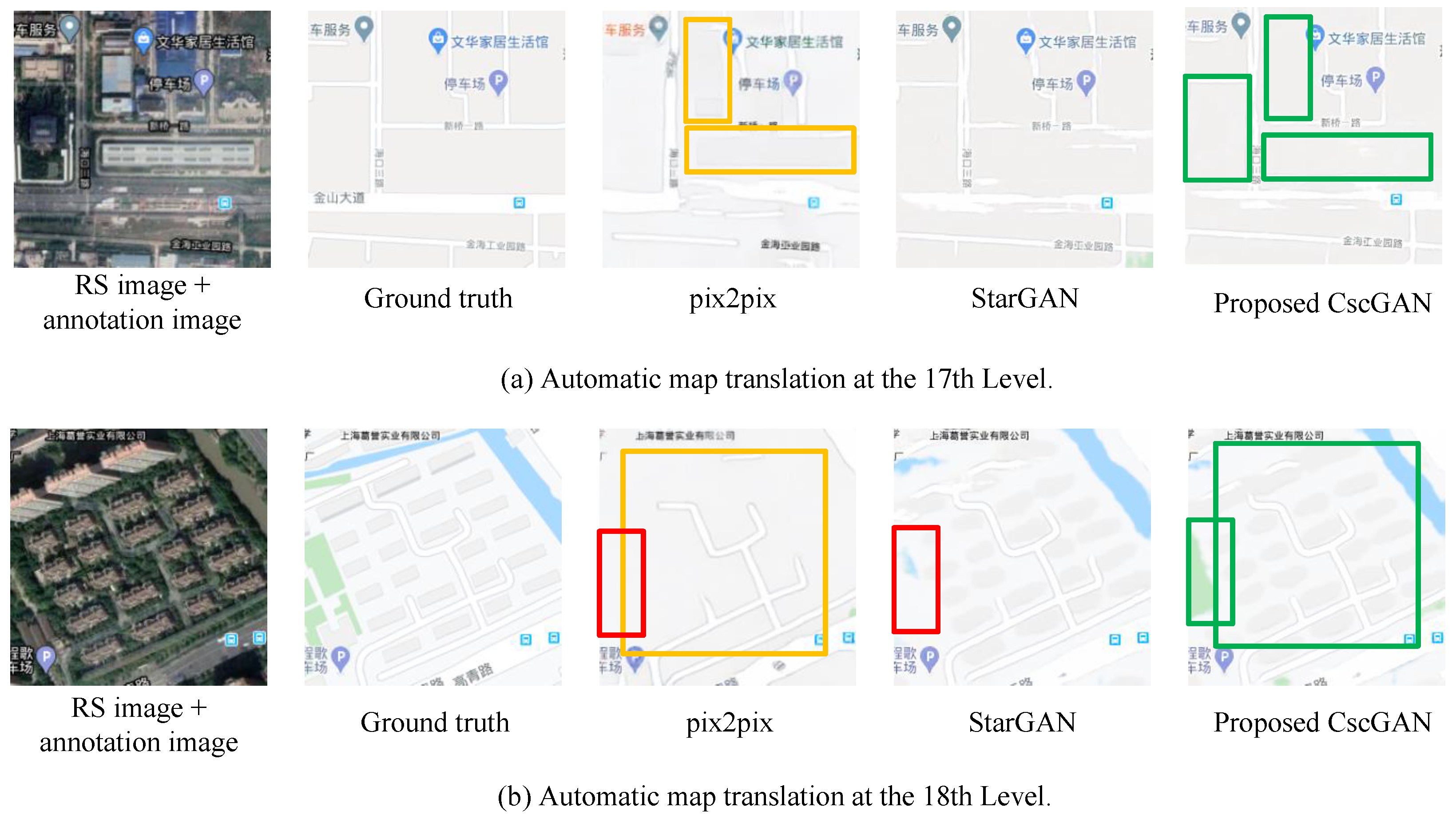
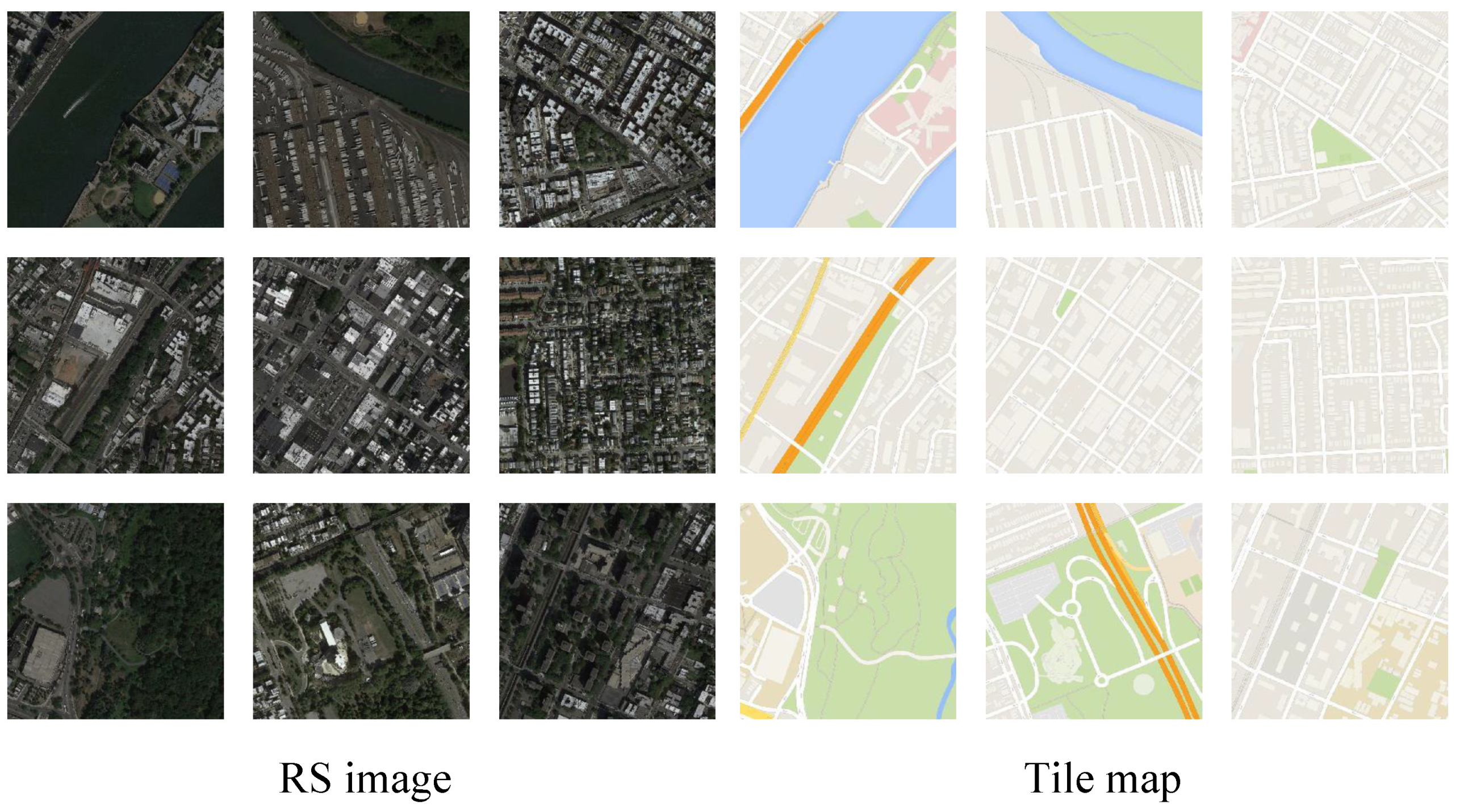
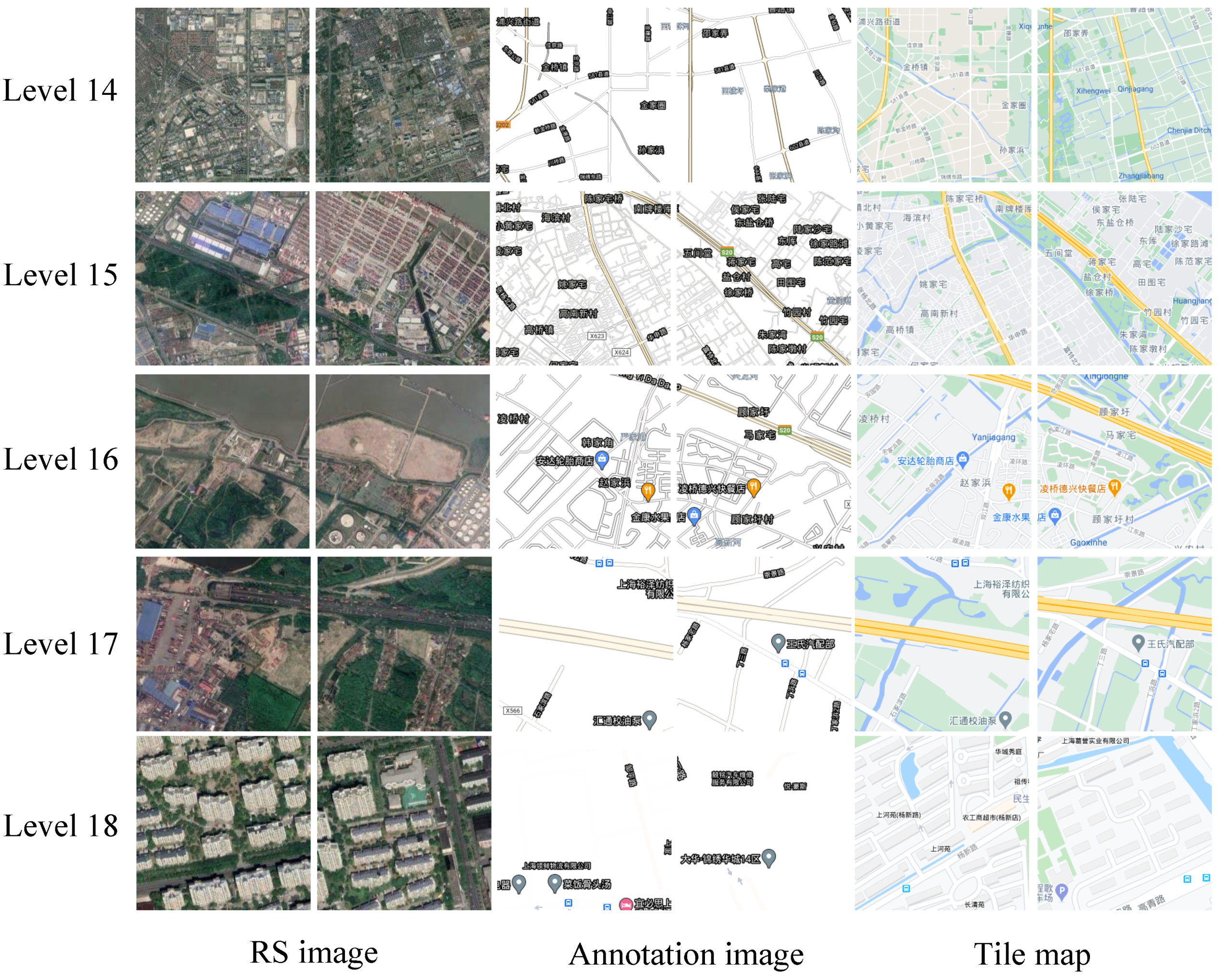
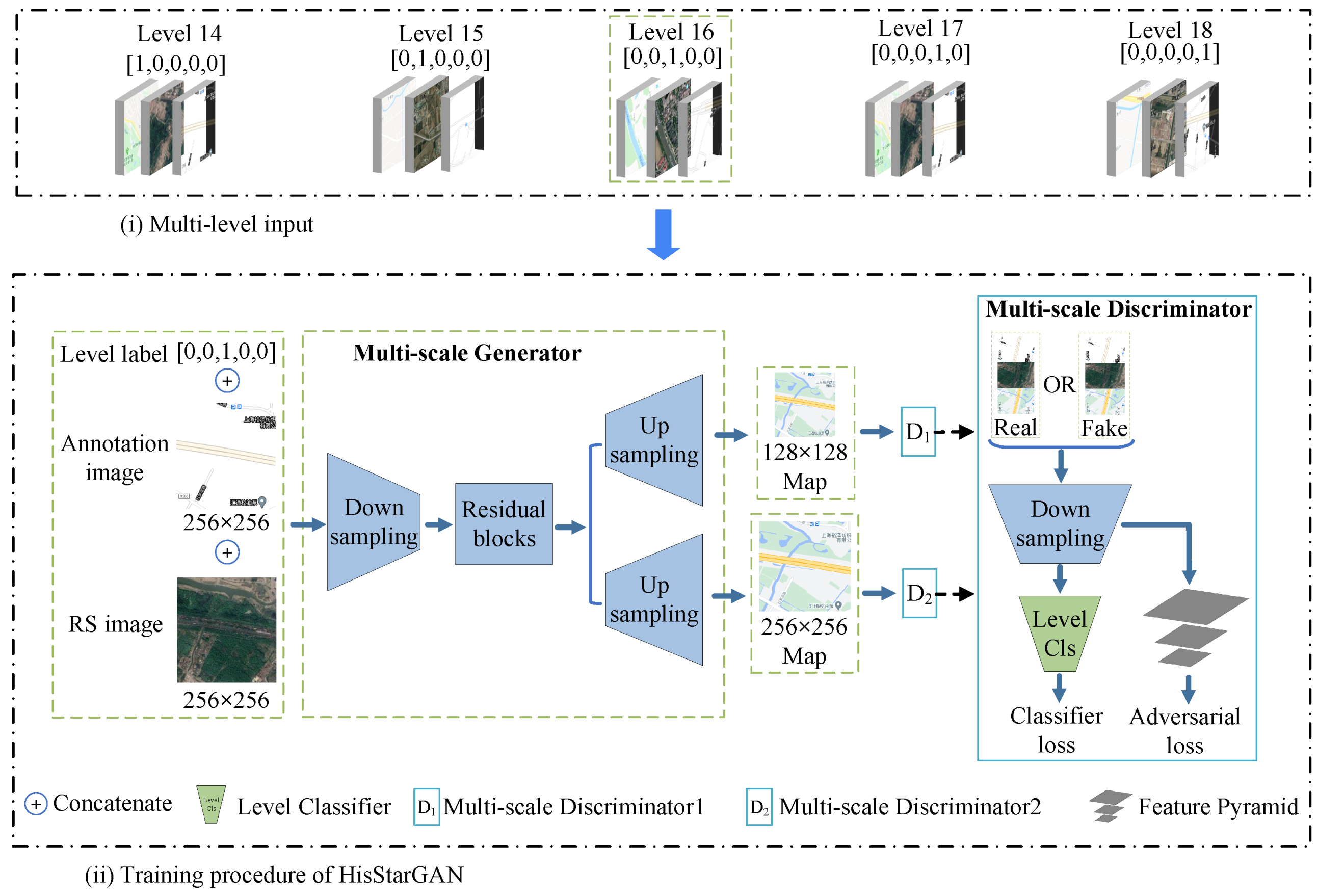

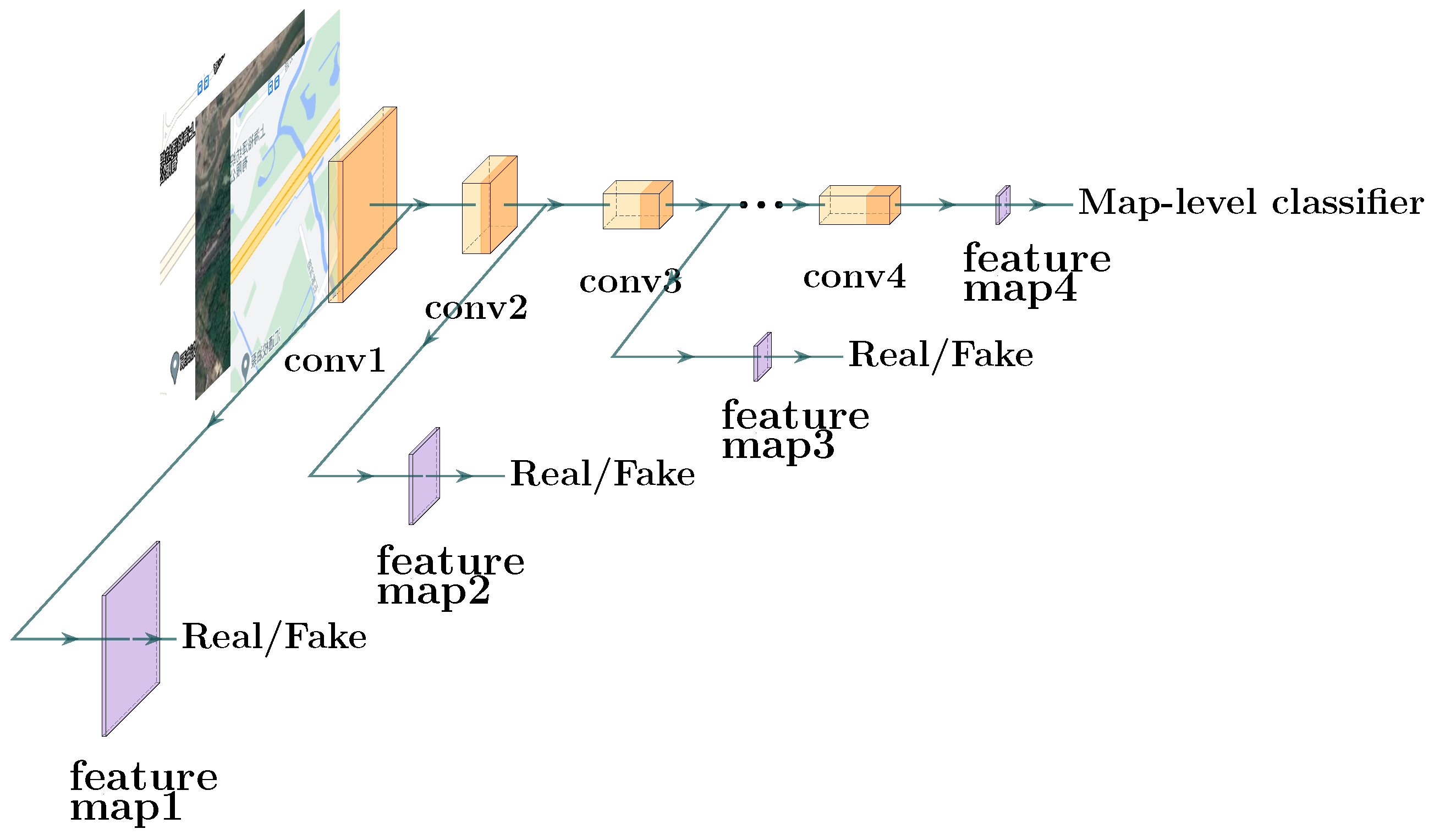
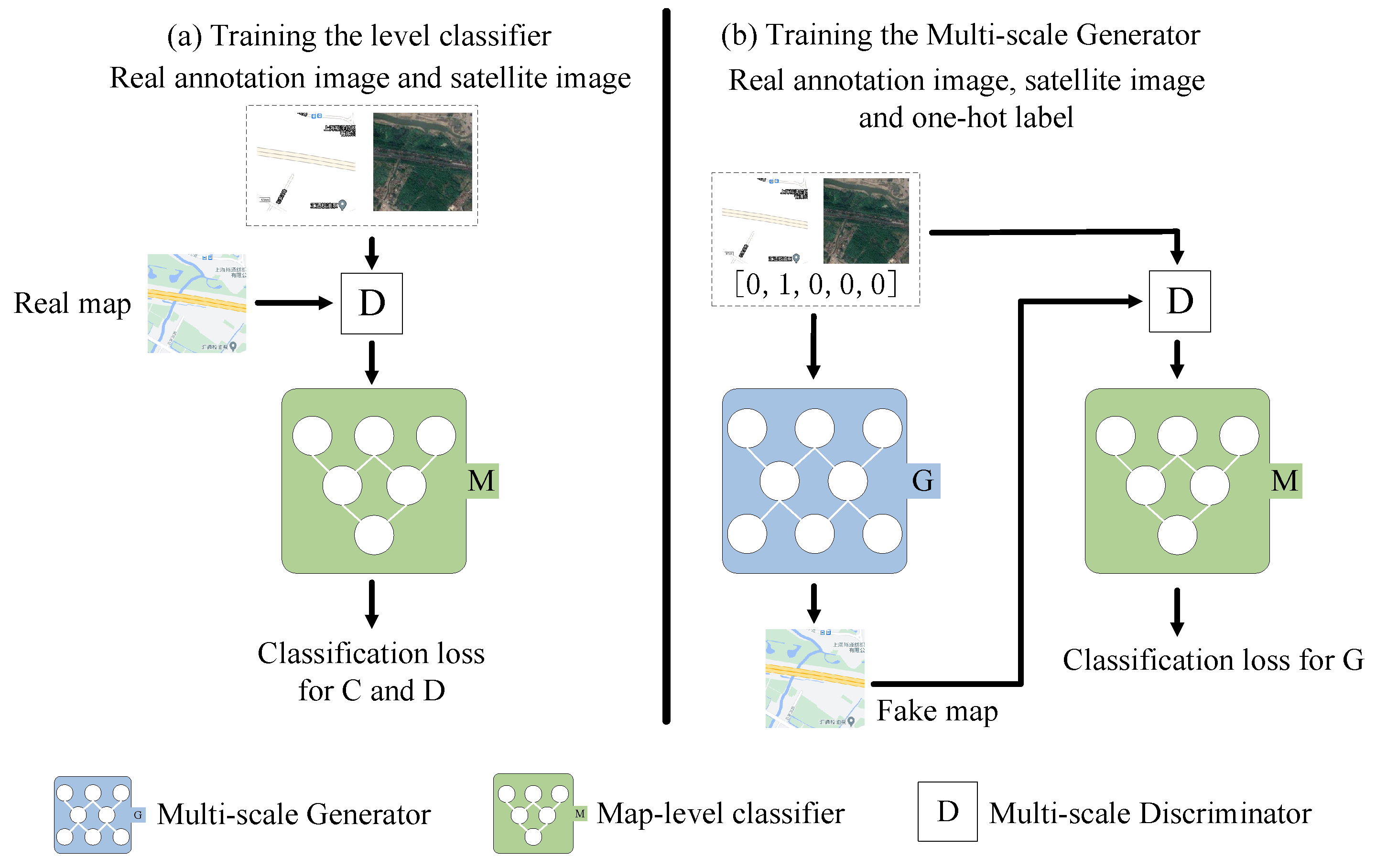
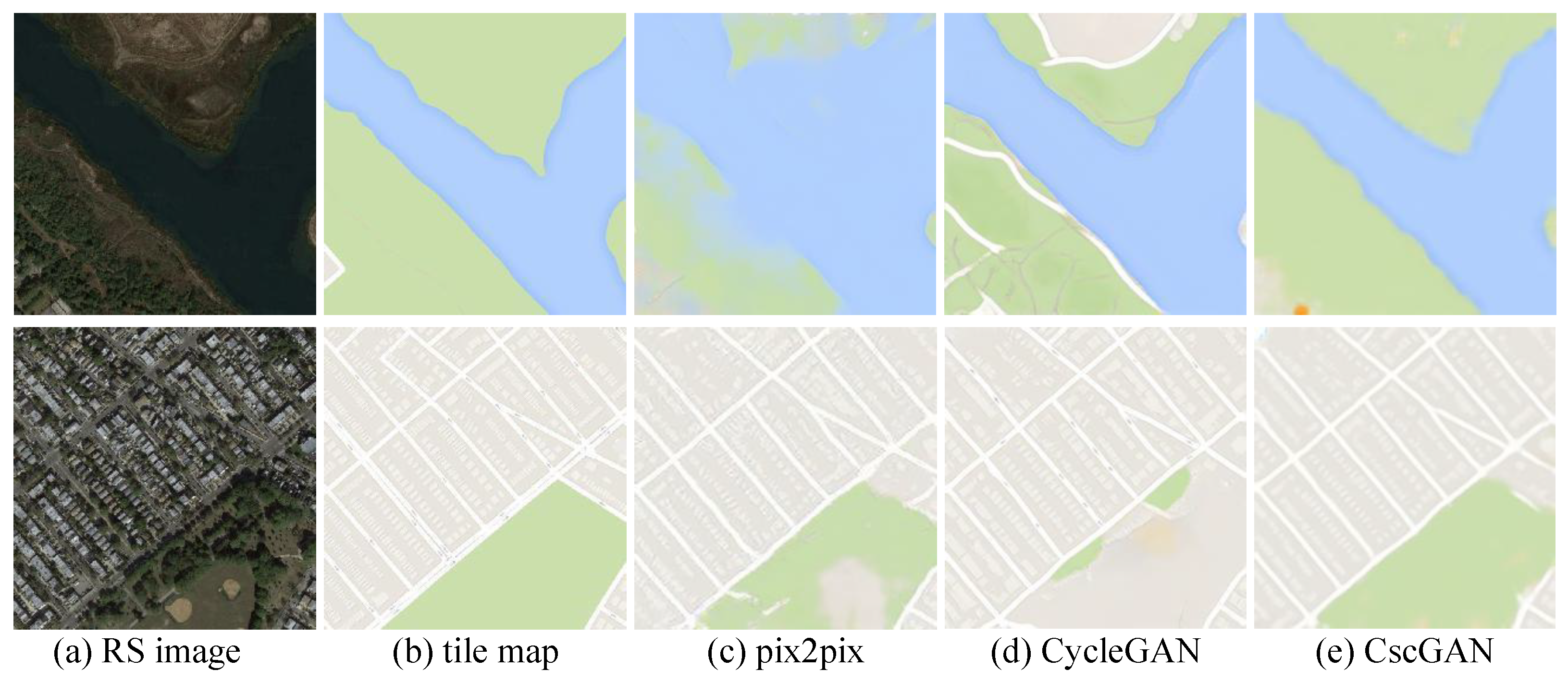
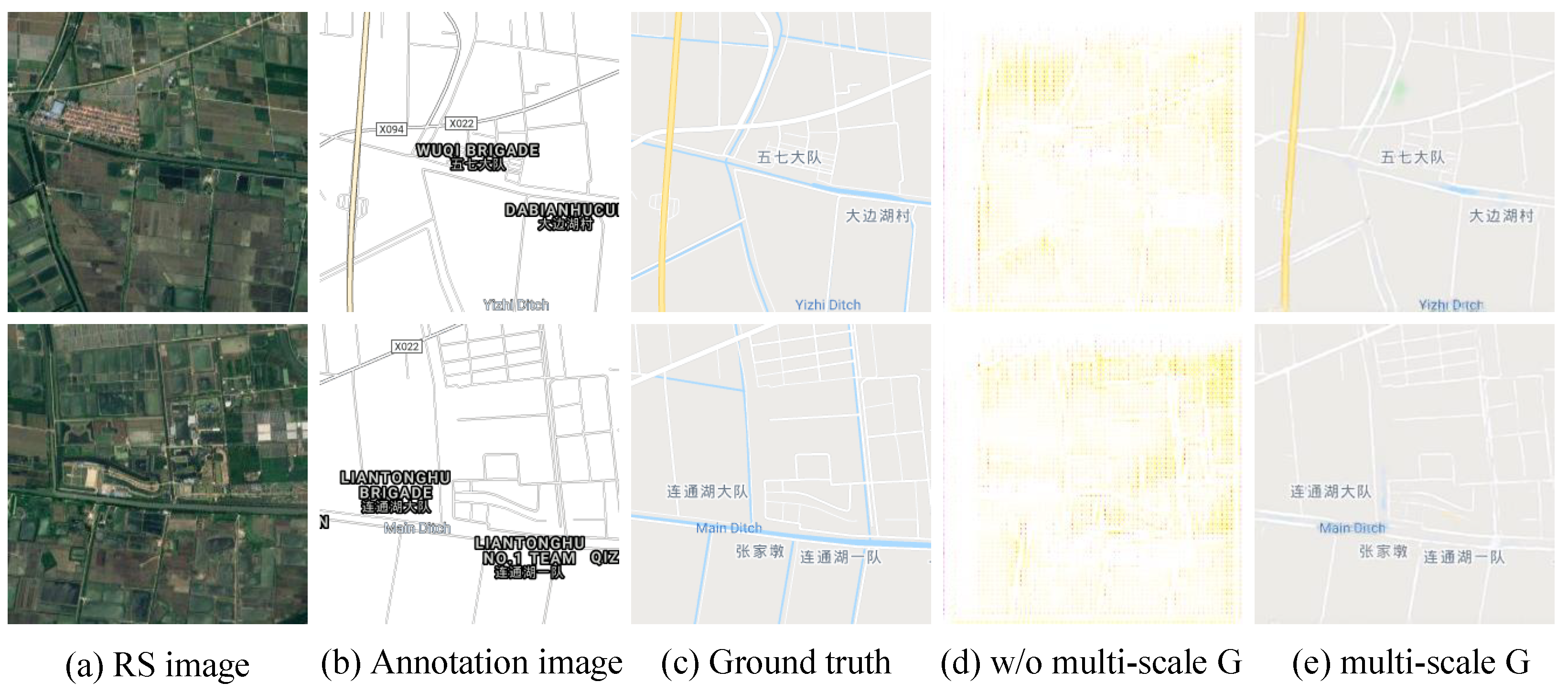
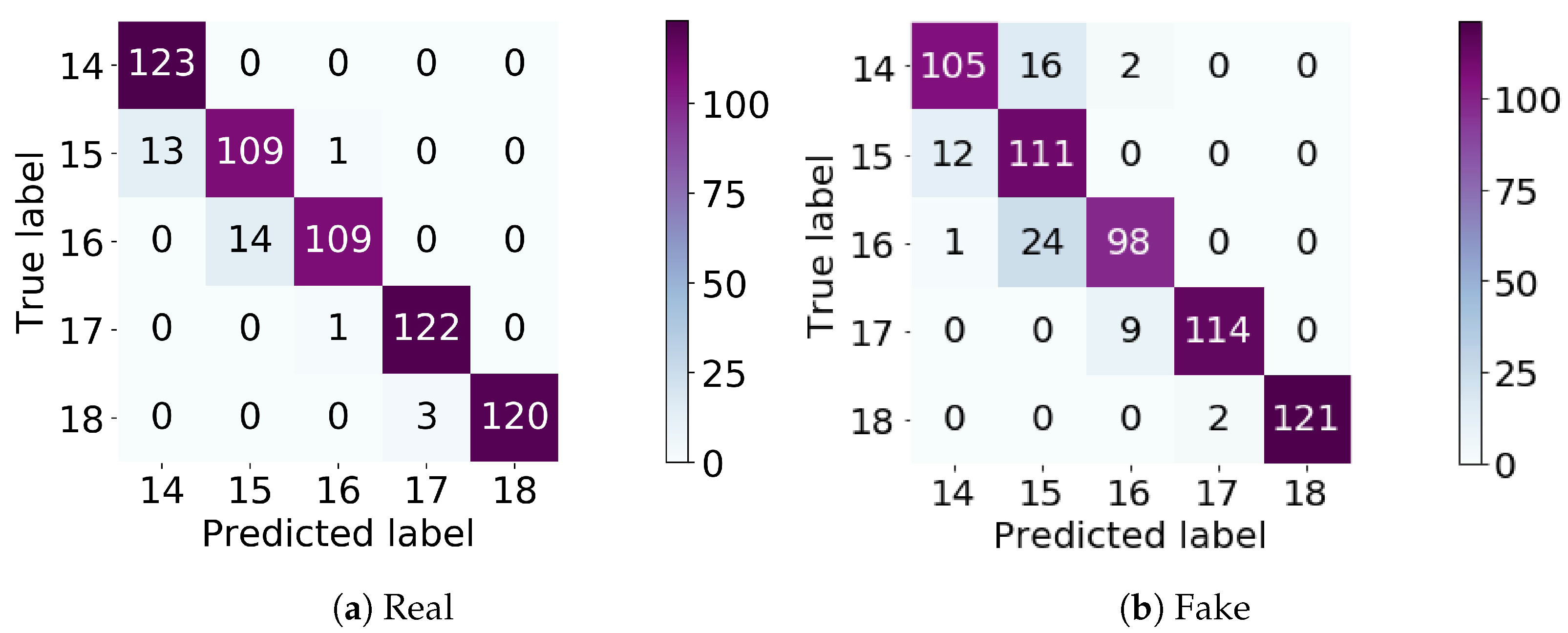
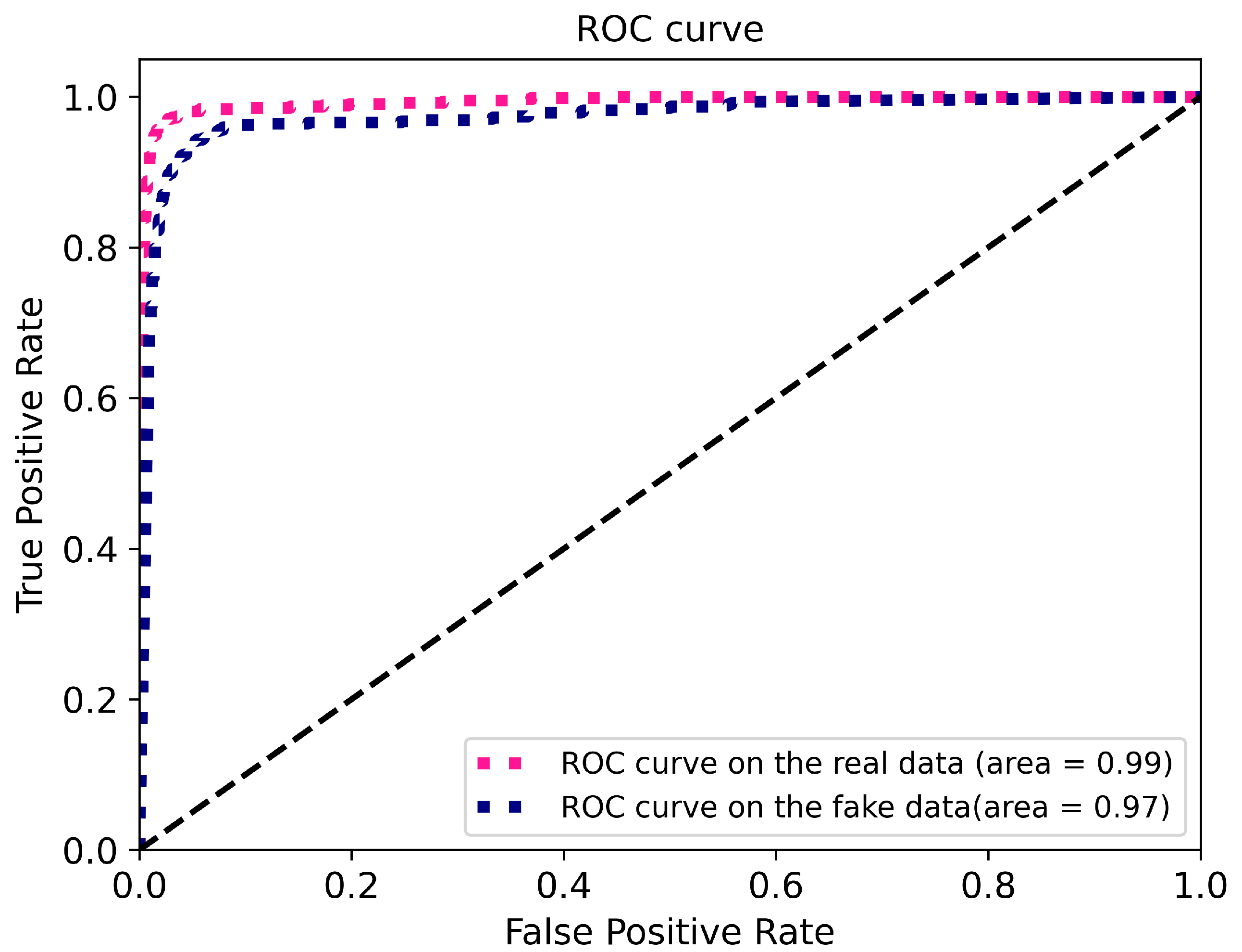
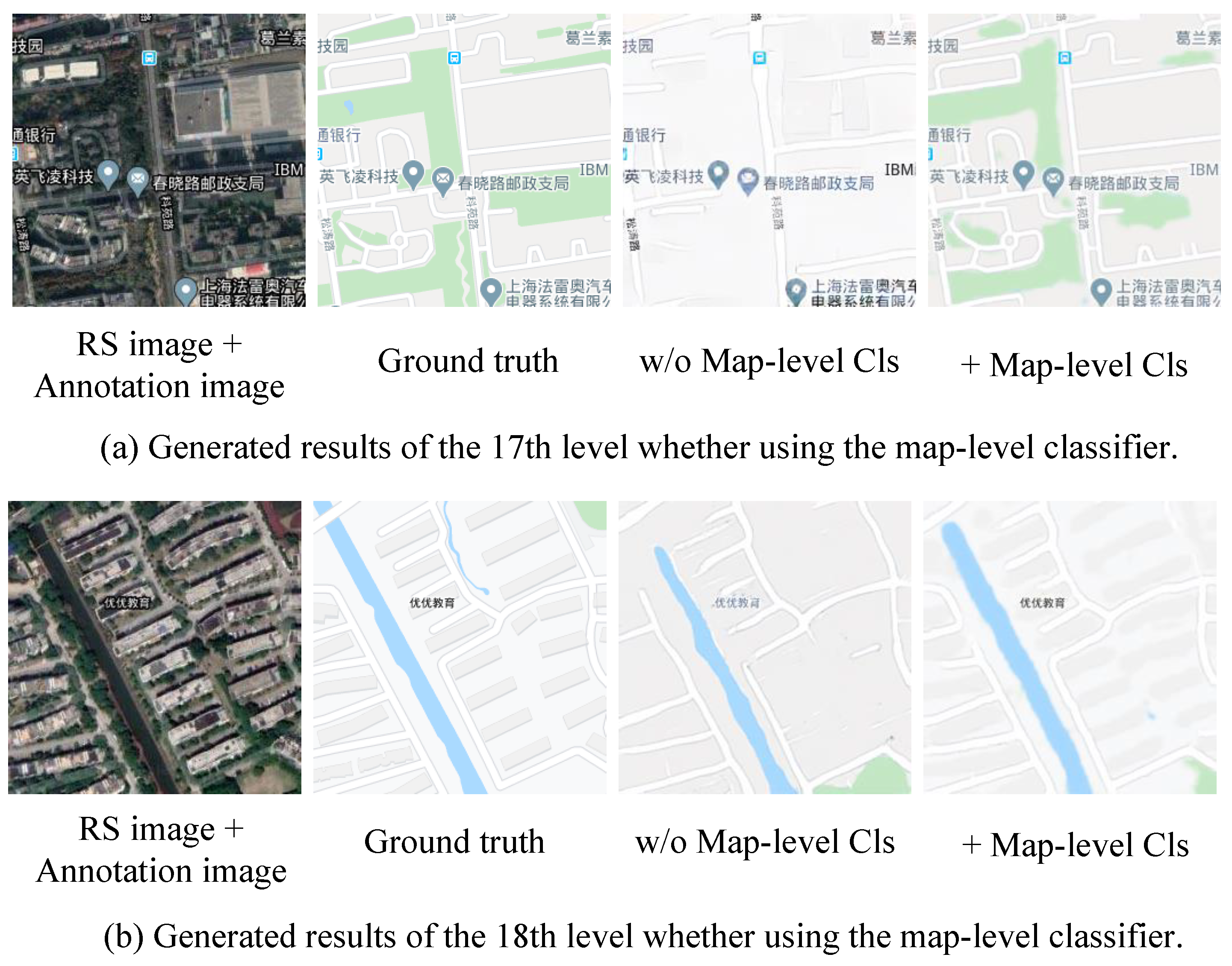
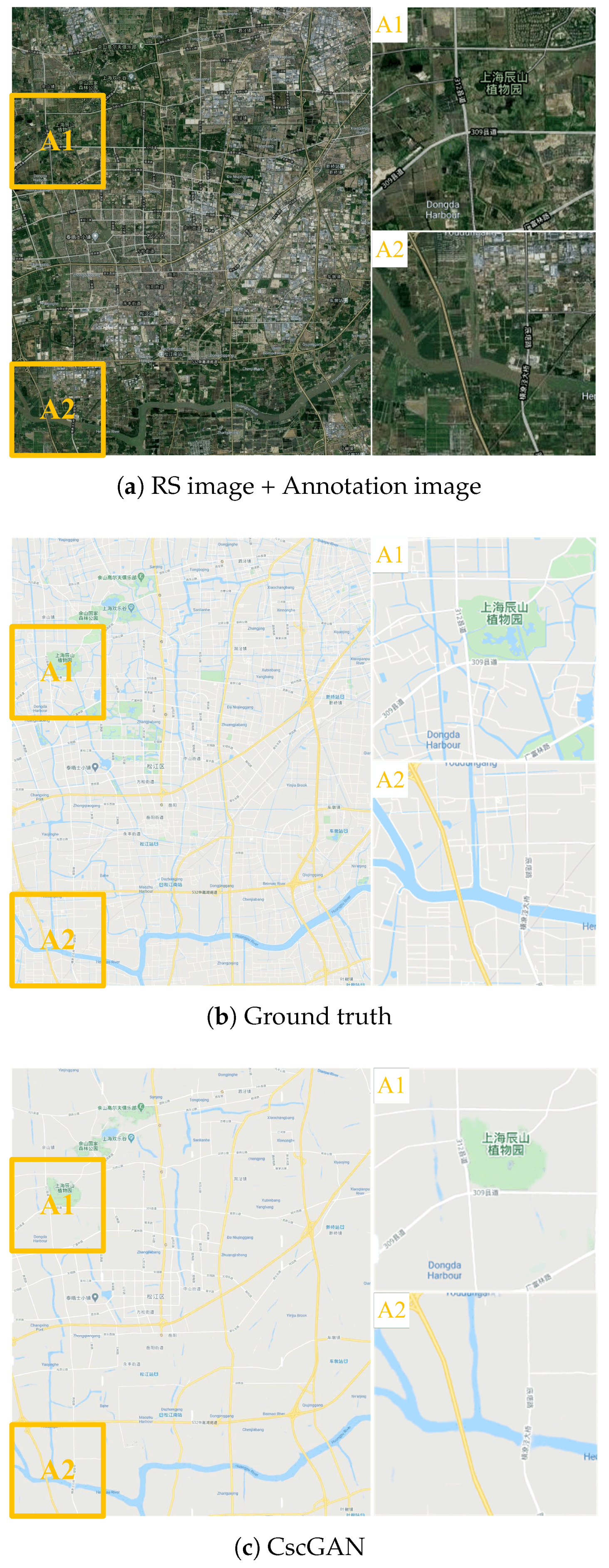
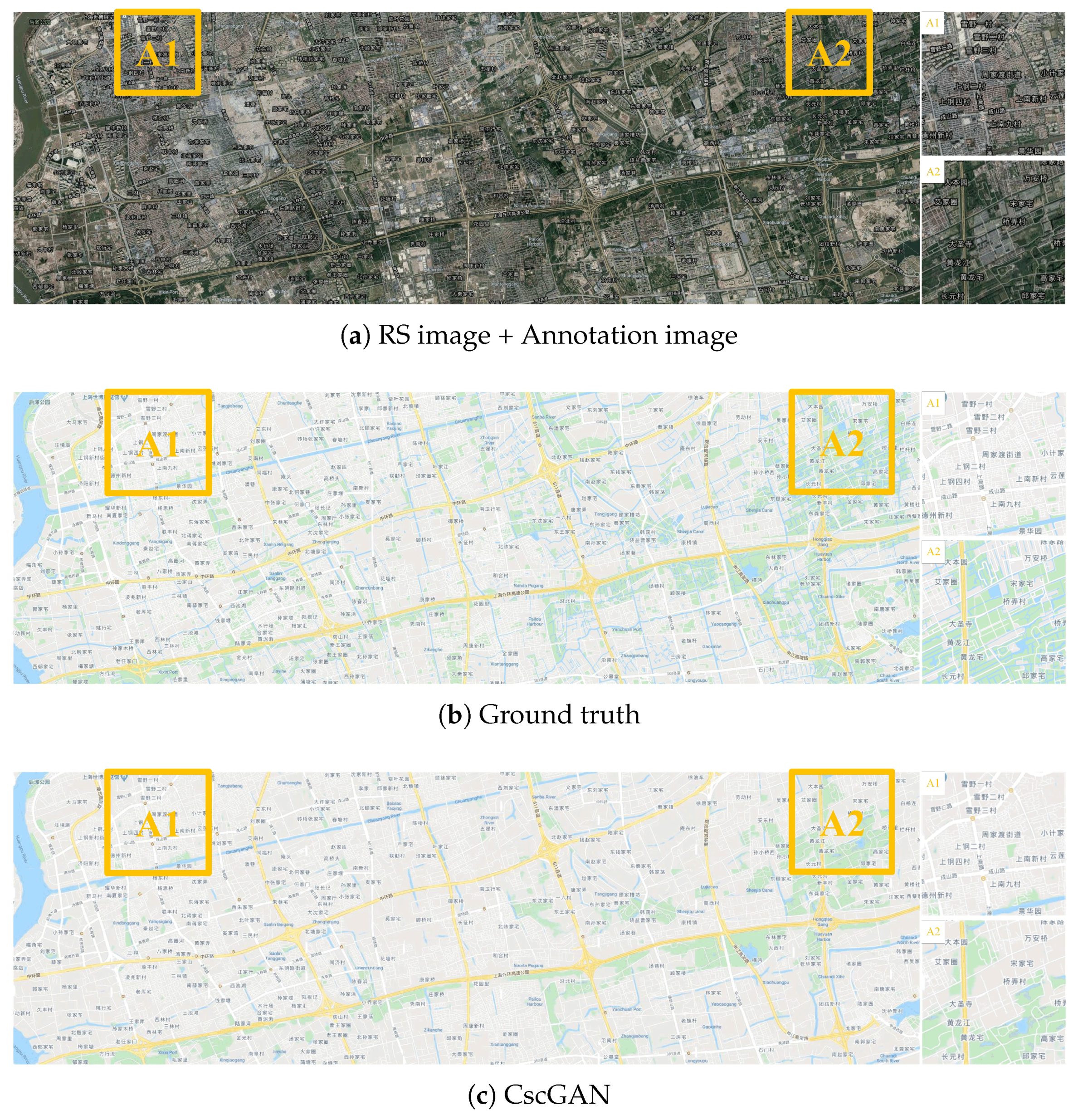
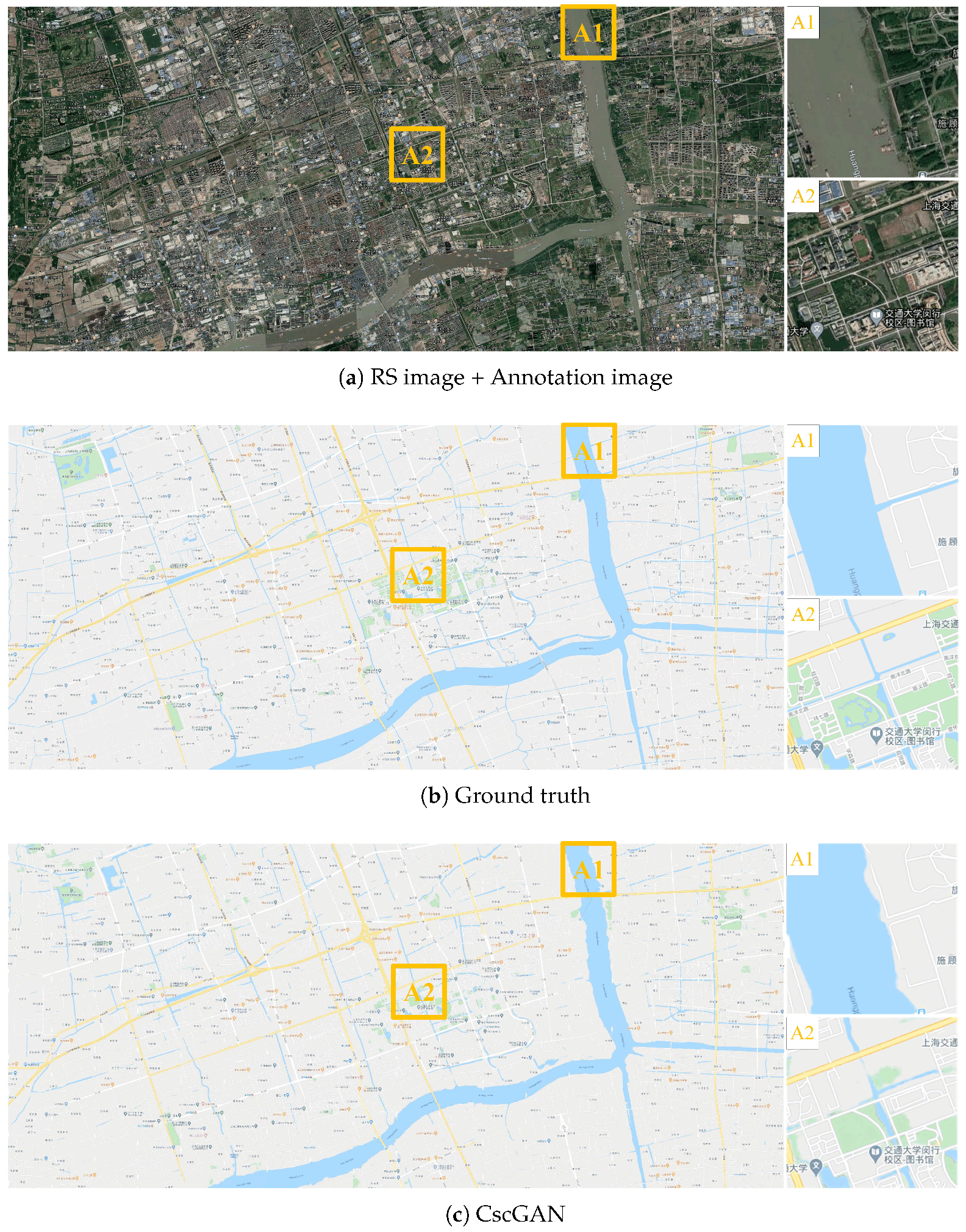

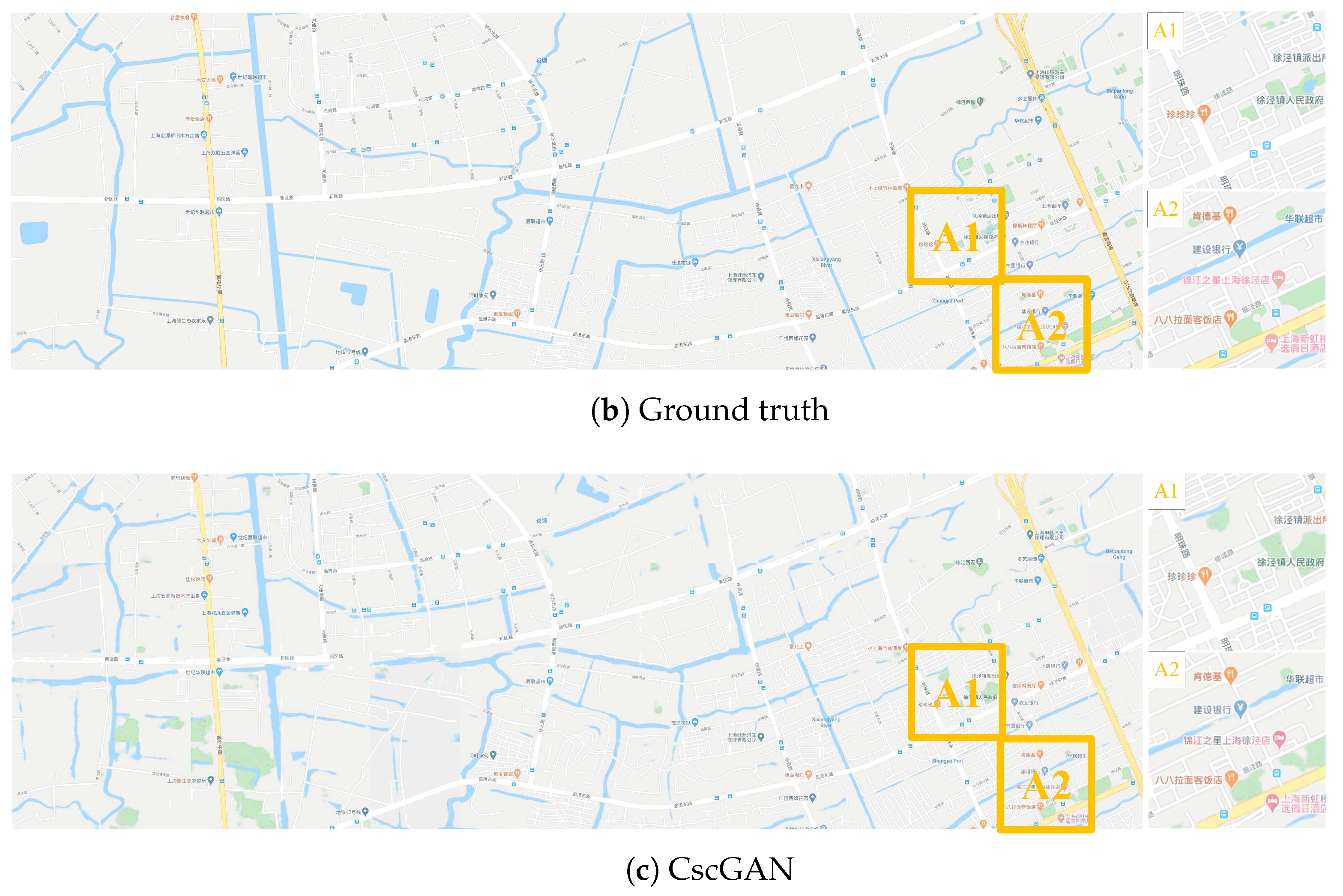

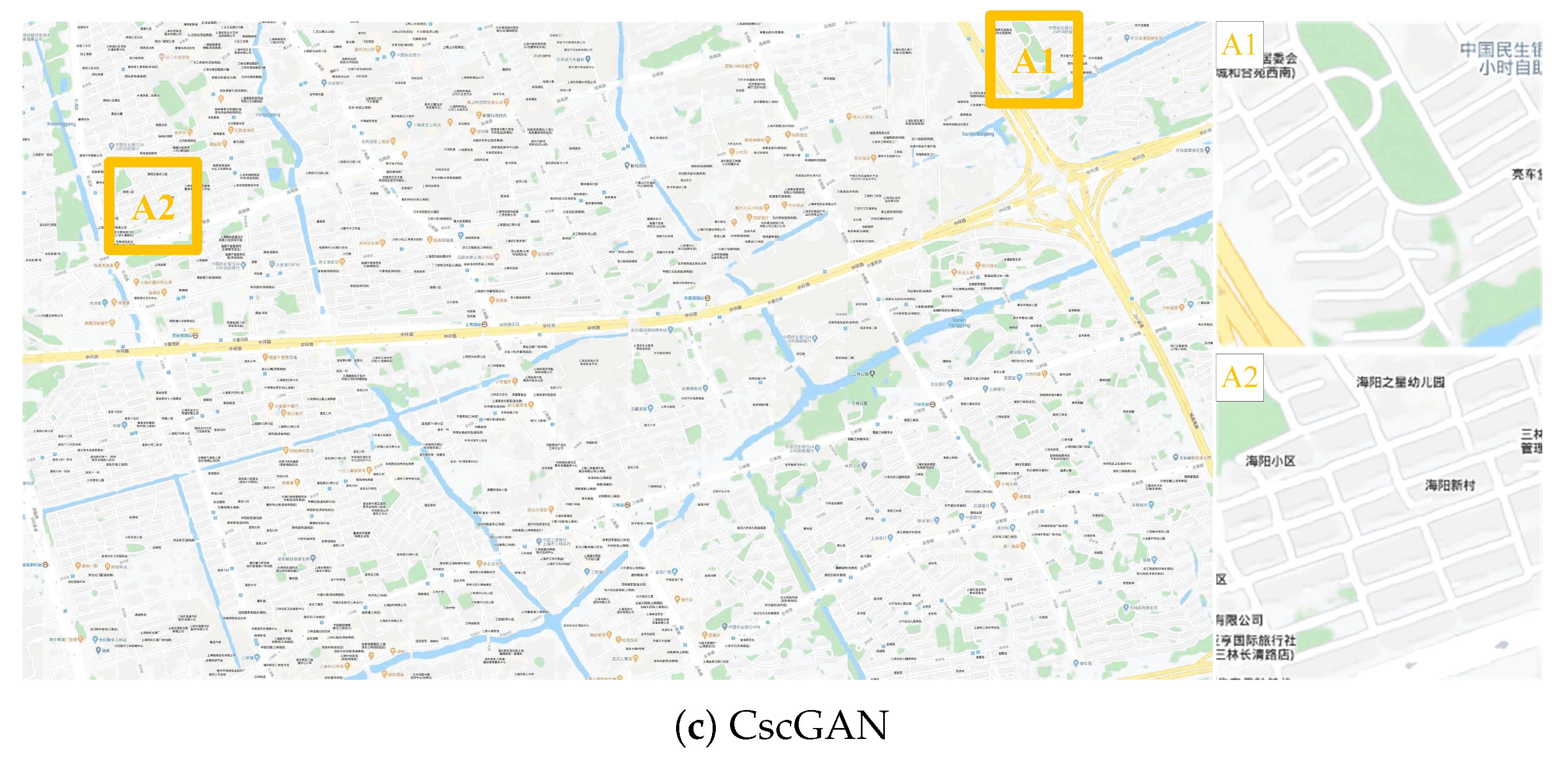
| Dataset | Training | Testing |
|---|---|---|
| Maps dataset | 1096 | 1098 |
| Self-annotated RS-image-to-map dataset | 6150 | 615 |
| Study Area | Level | Range | Scale | Spatial Resolution |
|---|---|---|---|---|
| Shanghai | 14 | 120.85, 31.53∼122.24, 30.67 | 1:72,223 | 19.109257 |
| (Songjiang District, | 15 | 120.85, 31.53∼122.24, 30.67 | 1:36,111 | 9.554629 |
| Pudong New District, | 16 | 121.14, 31.18∼121.53, 30.93 | 1:18,055 | 4.777314 |
| Minhang District, | 17 | 121.21, 31.18∼121.56, 30.93 | 1:9027 | 2.388657 |
| Qingpu District) | 18 | 120.89, 31.32∼121.67, 30.84 | 1:4513 | 1.94329 |
| Hubei | 14 | 113.35, 31.01∼114.42, 30.11 | 1:72,223 | 19.109257 |
| (Wuhan, | 15 | 113.53, 30.46∼114.20, 30.31 | 1:36,111 | 9.554629 |
| Yingcheng, | 16 | 114.04, 30.42∼114.26, 30.23 | 1:18,055 | 4.777314 |
| Xiaogan, | 17 | 114.09, 30.40∼114.21, 30.20 | 1:9027 | 2.388657 |
| Huanggang) | 18 | 114.09, 30.39∼114.23, 30.26 | 1:4513 | 1.94329 |
| Method | PSNR | SSIM | Pixel Accuracy |
|---|---|---|---|
| pix2pix [2] | 26.591 | 0.7 | 41.635% |
| CycleGAN [3] | 25.017 | 0.664 | 37.603% |
| Our CscGAN | 27.202 | 0.739 | 46.869% |
| Level | pix2pix [2] | CycleGAN [3] | StarGAN [5] | CscGAN | ||||||||
|---|---|---|---|---|---|---|---|---|---|---|---|---|
| PSNR | SSIM | Acc | PSNR | SSIM | Acc | PSNR | SSIM | Acc | PSNR | SSIM | Acc | |
| 14 | 27.1 | 0.734 | 65.356% | 23.899 | 0.652 | 60.165% | 28.008 | 0.784 | 74.097% | 28.011 | 0.785 | 74.361% |
| 15 | 27.503 | 0.871 | 65.817% | 21.163 | 0.65 | 51.984% | 27.192 | 0.853 | 64.831% | 27.194 | 0.852 | 64.835% |
| 16 | 25.5 | 0.838 | 63.370% | 21.344 | 0.698 | 54.083% | 26.412 | 0.864 | 65.940% | 26.371 | 0.864 | 66.057% |
| 17 | 26.861 | 0.868 | 69.660% | 21.548 | 0.732 | 60.208% | 27.79 | 0.885 | 71.694% | 27.83 | 0.886 | 71.707% |
| 18 | 25.192 | 0.768 | 49.415% | 18.115 | 0.532 | 34.526% | 25.935 | 0.808 | 51.791% | 25.98 | 0.809 | 51.053% |
| Avg | 26.432 | 0.816 | 62.724% | 21.214 | 0.653 | 52.193% | 27.067 | 0.839 | 65.671% | 27.077 | 0.839 | 65.602% |
| Methods | Params Size (MB) | Inference Time (ms) |
|---|---|---|
| pix2pix [2] | 269.9 | 0.011 |
| CycleGAN [3] | 539.5 | 0.008 |
| StarGAN [5] | 64.9 | 0.010 |
| CscGAN | 81.5 | 0.014 |
| Level | Baseline [2] | +Map-Level Cls | +Mult D | +Mult G | ||||||||
|---|---|---|---|---|---|---|---|---|---|---|---|---|
| PSNR | SSIM | Acc | PSNR | SSIM | Acc | PSNR | SSIM | Acc | PSNR | SSIM | Acc | |
| 14 | 27.1 | 0.734 | 65.356% | 27.923 | 0.782 | 73.549% | 27.988 | 0.783 | 73.281% | 28.011 | 0.785 | 74.361% |
| 15 | 27.503 | 0.871 | 65.817% | 27.103 | 0.845 | 63.661% | 27.156 | 0.846 | 63.106% | 27.194 | 0.852 | 64.835% |
| 16 | 25.5 | 0.838 | 63.370% | 26.248 | 0.859 | 64.723% | 26.295 | 0.86 | 64.299% | 26.371 | 0.864 | 66.057% |
| 17 | 26.861 | 0.868 | 69.660% | 27.478 | 0.878 | 70.486% | 27.654 | 0.88 | 69.862% | 27.83 | 0.886 | 71.707% |
| 18 | 25.192 | 0.768 | 49.415% | 26.014 | 0.807 | 51.174% | 26.24 | 0.808 | 51.548% | 25.98 | 0.809 | 51.053% |
| Avg | 26.432 | 0.816 | 62.724% | 26.953 | 0.834 | 64.718% | 27.067 | 0.835 | 64.419% | 27.077 | 0.839 | 65.602% |
| Level | pix2pix [2] | CycleGAN [3] | StarGAN [5] | CscGAN | ||||||||
|---|---|---|---|---|---|---|---|---|---|---|---|---|
| PSNR | SSIM | Acc | PSNR | SSIM | Acc | PSNR | SSIM | Acc | PSNR | SSIM | Acc | |
| 14 | 26.918 | 0.787 | 71.016% | 23.446 | 0.705 | 60.918% | 28.178 | 0.845 | 77.308% | 28.34 | 0.847 | 77.660% |
| 15 | 27.822 | 0.885 | 71.607% | 21.986 | 0.708 | 54.580% | 28.140 | 0.882 | 71.680% | 28.412 | 0.885 | 72.248% |
| 16 | 25.749 | 0.85 | 67.660% | 21.679 | 0.71 | 57.940% | 27.126 | 0.880 | 69.640% | 27.238 | 0.886 | 71.720% |
| 17 | 26.552 | 0.902 | 74.775% | 20.336 | 0.73 | 58.452% | 27.723 | 0.917 | 75.833% | 27.506 | 0.918 | 75.714% |
| 18 | 26.924 | 0.808 | 48.979% | 17.244 | 0.538 | 33.738% | 27.246 | 0.841 | 49.229% | 27.113 | 0.843 | 48.627% |
| Avg | 26.793 | 0.846 | 66.807% | 20.938 | 0.678 | 53.126% | 27.683 | 0.873 | 68.738% | 27.722 | 0.876 | 69.194% |
Publisher’s Note: MDPI stays neutral with regard to jurisdictional claims in published maps and institutional affiliations. |
© 2021 by the authors. Licensee MDPI, Basel, Switzerland. This article is an open access article distributed under the terms and conditions of the Creative Commons Attribution (CC BY) license (https://creativecommons.org/licenses/by/4.0/).
Share and Cite
Liu, Y.; Wang, W.; Fang, F.; Zhou, L.; Sun, C.; Zheng, Y.; Chen, Z. CscGAN: Conditional Scale-Consistent Generation Network for Multi-Level Remote Sensing Image to Map Translation. Remote Sens. 2021, 13, 1936. https://doi.org/10.3390/rs13101936
Liu Y, Wang W, Fang F, Zhou L, Sun C, Zheng Y, Chen Z. CscGAN: Conditional Scale-Consistent Generation Network for Multi-Level Remote Sensing Image to Map Translation. Remote Sensing. 2021; 13(10):1936. https://doi.org/10.3390/rs13101936
Chicago/Turabian StyleLiu, Yuanyuan, Wenbin Wang, Fang Fang, Lin Zhou, Chenxing Sun, Ying Zheng, and Zhanlong Chen. 2021. "CscGAN: Conditional Scale-Consistent Generation Network for Multi-Level Remote Sensing Image to Map Translation" Remote Sensing 13, no. 10: 1936. https://doi.org/10.3390/rs13101936
APA StyleLiu, Y., Wang, W., Fang, F., Zhou, L., Sun, C., Zheng, Y., & Chen, Z. (2021). CscGAN: Conditional Scale-Consistent Generation Network for Multi-Level Remote Sensing Image to Map Translation. Remote Sensing, 13(10), 1936. https://doi.org/10.3390/rs13101936









